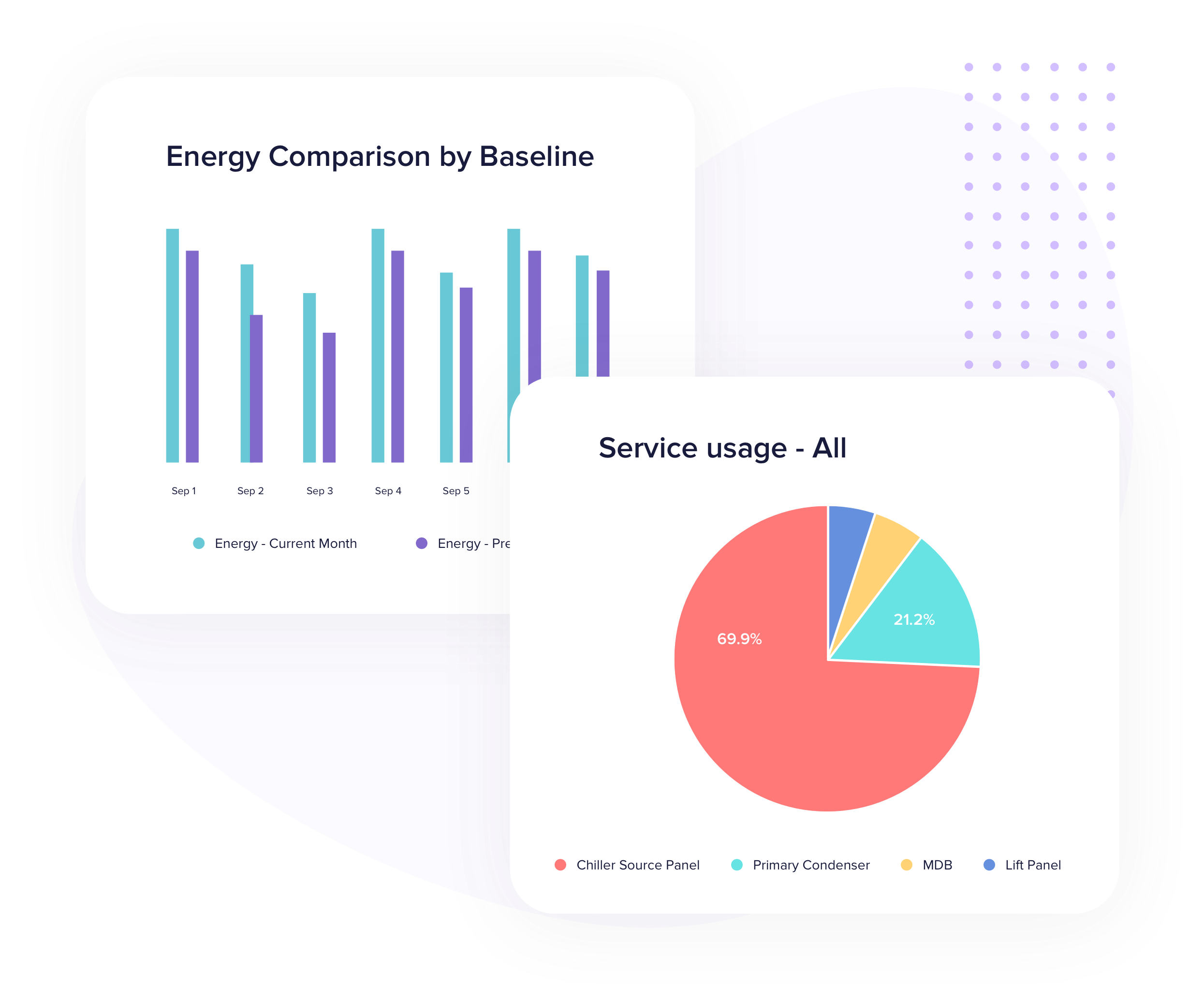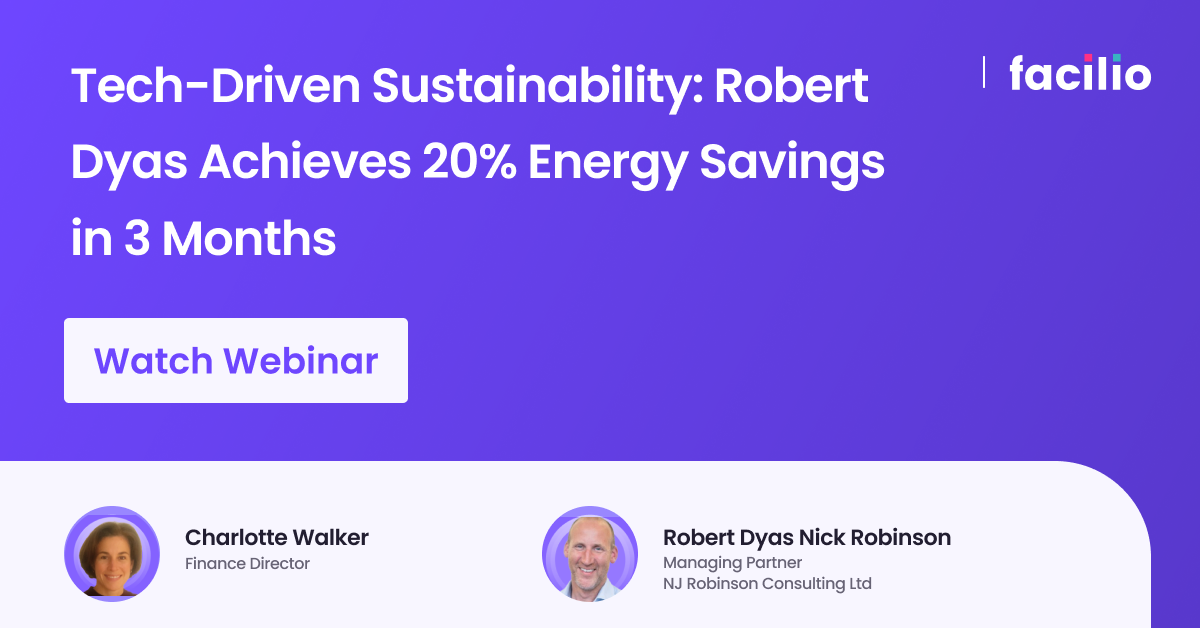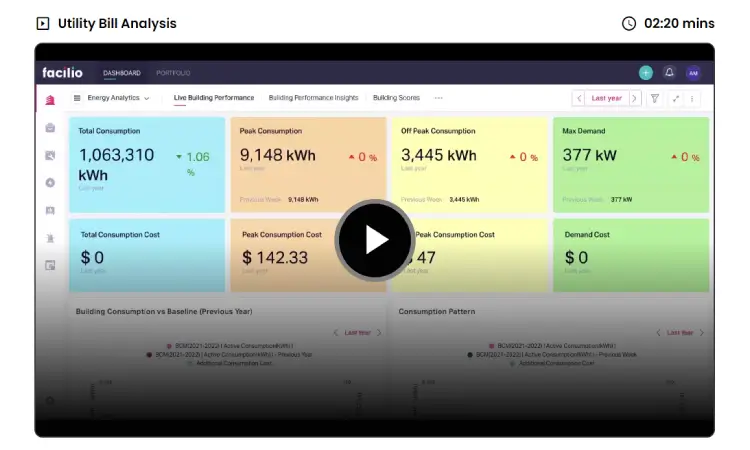A Complete Guide to Sustainable Facilities Management

As a forward-thinking facilities manager, you recognize that entrepreneurial spirit and environmental stewardship go hand-in-hand.
Implementing sustainable practices not only proves to be cost-effective in the long run but also improves the occupants’ overall well-being. Moreover, with a mission to achieve net-zero CO2 emissions by 2050, sustainability has become a C-suite issue.
However, paving the way to a greener future can feel overwhelming, especially when sustainability efforts fall on your already busy shoulders.
From identifying the best sustainability practices and implementing them, to training staff and curating a sustainable energy and environmental design, each phase of sustainable facilities management presents its challenges.
That’s where this blog post comes in. Consider it as your comprehensive guide to overcoming these hurdles.
Get ready to dive deep into sustainable facilities management, smart implementation strategies, and its numerous benefits!
What is sustainable facilities management?
Every phase of facilities management can be environmentally optimized—from design and construction to operations, periodic maintenance, and eventual disposal.
At each phase, implementing sustainable practices minimizes environmental impact, enhances energy efficiency, and ensures the facility’s long-term viability.
Why is sustainable facilities management important?
The buildings and construction sector account for a staggering 37% of global emissions. Without sustainable practices, higher operational costs and resource shortages become inevitable.
Implementing sustainable facilities management reduces carbon footprints, conserves natural resources, and fosters a healthier environment. Moreover, it helps organizations comply with ever-evolving regulations, meet corporate social responsibility (CSR) goals, and improve occupants’ health.
Effective sustainable facilities management solutions increase energy efficiency, reduce waste generation, and mitigate climate change.
For instance, energy-efficient buildings dramatically improve the air quality, directly benefiting those living or working in such spaces.

Benefits of sustainable facilities management
Sustainable facilities management benefits FM leaders, the occupants, and our planet. Let’s see how.
1. Environmental impact
Sustainable facilities management helps reduce greenhouse gas emissions by implementing energy-efficient systems, optimizing water usage, and reducing waste generation. This way, it minimizes the carbon footprint and promotes the usage of renewable energy sources.
2. Economic savings
By identifying and implementing energy-saving opportunities, such as optimizing heating, ventilation, air conditioning, and refrigeration (HVACR) systems and reducing heating temperatures, facilities can achieve substantial cost savings.
Additionally, artificial intelligence (AI) led energy optimization solutions help monitor and manage energy consumption effectively, further reducing costs associated with excessive fuel, water, or energy usage.
3. Improved occupant health and well-being
Facilities designed with proper access to natural light and up-to-date systems automatically contribute to a healthier environment. Real-time optimization of environmental controls ensures a comfortable indoor climate, enhancing the well-being and productivity of occupants while maintaining energy efficiency.
4. Regulatory compliance
A software-led approach ensures all your facilities comply with government and industry standards for sustainability. For example, if a facility fails to follow Federal guidelines, a centralized system alerts you so that you can take the necessary action.
How can a facilities management team boost sustainability efforts?
The physical retrofitting techniques such as installing up-to-date HVAC systems, incorporating solar panels, etc. help. However, software-led energy optimization helps you achieve sustainability goals quicker and with better accuracy.
A facilities management team can:
- Implement a comprehensive system that integrates lighting, security, and other systems for centralized monitoring and control
- Automate energy-saving measures like adjusting the cooling and heating temperatures based on occupancy, time of the day, etc.
- Monitor real-time energy consumption, study patterns, and predict potential inefficiencies leading to proactive management
- Integrate every sensor with the system to get granular data for analysis
- Configure role-specific dashboards and asset-specific KPIs to measure results against the sustainability goals benchmarks
Overall, a software-led approach saves time, costs, and energy for you to focus on developing smart sustainability initiatives.
Ways to implement sustainable facilities management
Property leaders aiming for decarbonization face significant challenges that must be addressed holistically.
Challenges
1. Siloed data systems
Tradition FM systems have fragmented data. So, data related to energy management, maintenance schedules, and equipment performance are isolated from each other. Such systems often offer a comprehensive portfolio to facilities managers due to inconsistent, redundant processes and a lack of real-time insights into overall facility performance.
2. Lack of visibility
Lack of visibility is a direct result of siloed data systems. Since data isn’t centralized, facilities managers don’t get comprehensive visibility across departments. This results in inadequate data monitoring, energy wastage, and even equipment failures, leaving FM leaders confused about the next course of action.
3. Reliance on point solutions
While standalone software tools address and solve individual issues, they make it difficult to benchmark performance against sustainability goals across all facilities. It might suffice for a single sustainable facility management but fails in the case of multiple facilities.
Integrated solutions
To tackle these challenges comprehensively, industry leaders are adopting connected operations platforms. A unified platform that brings them data from assets across their entire portfolio and offers real-time insights into energy usage patterns.
- Cloud-based supervisory platforms
Deploy centralized platforms for dynamic adjustments and centralized control to optimize energy consumption in real time. - Unified data platforms
Implement vendor-neutral solutions that streamline data access across portfolios, enabling holistic optimization and efficiency improvements. - Advanced strategies
Utilize suction pressure optimization and fault detection systems to enhance equipment efficiency and reduce energy consumption. - Renewable energy integration
Upgrade to energy-efficient technologies and integrate renewable energy sources to reduce carbon footprints and achieve long-term cost savings.
With Facilio’s cloud-based connected buildings solution, they were able to enhance occupant comfort by bringing together data from across 9000 assets, leading to a 50% reduction in lighting and energy costs within two months.
Step-by-step guide to switching your software solution provider
Switching to another software solution provider is a complex process. However, this step-by-step approach simplifies it.
1. Assess current provider
Evaluate the sustainability practices of your current provider. How? For example, if your goal is to reduce energy consumption in Facility A, use smart meters to benchmark energy usage against industry standards. If your existing system lacks comprehensive data, consider a system that offers this capacity.
2. Research options
Look for providers with strong sustainability credentials such as an ISO 140001 or Leadership in Energy and Environmental Design (LEED) accreditation.
3. Request proposals
Draft detailed requests for proposals that outline your sustainability goals, energy efficiency, carbon footprint, and other eco-friendly practices. Solicit proposals from potential providers.
4. Evaluate proposals
Assess proposals based on your sustainability goals, cost (both upfront and long-term), service quality, and customer support.
5. Transition plan
Develop a plan for a smooth transition to the new provider. Keep the stakeholders and team members informed of this change and the reasons behind it. Create an outline for steps needed for data migration, training and support, and monitoring the performance of the new system.
The future of sustainable facilities management
The integration of AI and the IoT is pivoting facilities management, making it smarter and more efficient.
Today, sustainable facility management solutions such as planned preventive maintenance let FM leaders foresee equipment failures before they occur with real-time data monitoring and smart sensors. This extends the lifespan of assets and increases the energy efficiency of the facility.
Government bodies are also promoting the use of renewable energy sources and implementing stringent environmental regulations. It ensures buildings meet high sustainability benchmarks and keeps pushing the industry toward greener practices.
Industries on the other hand continue to develop new sustainable materials during the construction of buildings. For example, reusing plastic as a construction material is a popular practice.
With growing global emphasis on sustainability and green practices, industry leaders and government bodies are certain to keep striving for a smarter, greener future.
Software-led energy optimization for enterprise facility/property operations
Implementing sustainable facilities management doesn’t require you to disrupt your existing systems. Instead, it calls for advanced management software that streamlines sustainability efforts by creating a closed-loop system.
Facilio’s connected buildings solution offers a comprehensive portfolio view, effectively bridging the gap between your CSR goals and sustainability targets.
Melbourne's renowned university with seven campuses spanning over 2,500 hectares aimed to increase sustainability goals and increase savings by lowering utility costs.

Get in touch to learn how Facilio helps you achieve your goal to ‘go green(er)’ and turn your existing FM system into a sustainable powerhouse.
Metrics to measure the success of sustainable facilities management
Implementing sustainable facilities management is step 1. Step 2 is gathering valuable insights on how well sustainability initiatives are performing. Let’s look at all these metrics.
Energy performance metrics
1. Energy consumption (kWh)
It’s the total amount of electrical energy used by facilities. It acts as a fundamental indicator of energy demand and a baseline for identifying energy-saving opportunities.
2. Energy demand (kW)
Energy demand is the rate at which energy is used at a given moment. It helps identify peak loads and implement strategies to reduce demand charges. Use internet of things (IoT) technology to measure and monitor this metric for all facilities.
3. Energy use intensity (EUI)
EUI is simply energy consumed per square foot of building area.
4. Carbon footprint
Carbon footprint is the total CO2 equivalent emissions from energy use. It tracks progress toward carbon reduction goals and evaluates environmental impact.
5. Energy cost
Energy cost is the total monetary expense of energy consumption. Energy accounting lets you track the energy consumed and its cost which is essential for budgeting and identifying cost-saving measures.
Asset performance metrics
Along with having sufficient data on the energy usage patterns of the facilities, you need to ensure optimal asset performance. These metrics will help you measure the assets’ performance.
1. Equipment uptime
Percentage of time equipment is operational. So a high uptime indicates reliable equipment and minimal disruption to building operations.
2. Mean time between failures (MTBF)
MTBF is the average time between equipment breakdowns. A longer MTBF indicates better equipment reliability and less need for reactive maintenance.
3. Mean time to repair (MTTR)
MTTR is the average time to fix equipment after a breakdown. A shorter MTTR indicates efficient maintenance processes and lesser downtime.
4. Overall equipment effectiveness (OEE)
OEE is a holistic metric assessing availability, performance, and quality. It reflects the overall productivity and effectiveness of equipment.
5. Asset condition index
It’s a score representing the overall health of equipment. It helps prioritize maintenance activities and predict potential failures.
Maintenance operations metrics
54% of all maintenance costs are for preventative maintenance. Use these metrics to identify assets consuming high energy and optimize them.
1. Planned maintenance percentage (PMP)
PMP is the proportion of scheduled maintenance. A high PMP indicates a proactive approach to maintenance, minimizing breakdowns and extending equipment life.
2. Preventive maintenance compliance (PMC)
PMC is the percentage of planned tasks completed on time. A high PMC indicates effective adherence to maintenance schedules, ensuring optimal equipment performance.
3. Reactive maintenance percentage (RMP)
RMP gives the proportion of unplanned maintenance. A high RMP suggests a need for improved preventive maintenance practices to reduce unexpected breakdowns.
4. Work order completion time
It's the average time to complete maintenance tasks. So a shorter time indicates efficient maintenance processes and faster response to issues.
5. Maintenance cost
It’s the total cost of maintenance activities. It tracks expenses, identifies cost-saving opportunities, and budgeting effectively.
Sustainability metrics
Monitor these metrics to achieve your sustainability goals.
1. Water consumption
It shows the total water usage, tracks water consumption patterns, identifies leaks, and supports water conservation efforts.
2. Waste generation
This is the total waste produced. It measures the effectiveness of waste reduction strategies and informs recycling initiatives.
3. Indoor air quality (IAQ) score
IAQ is a composite score reflecting air quality parameters. It ensures a healthy and comfortable indoor environment for occupants, contributing to their well-being and productivity.
4. Green building certification points
It shows progress towards certifications like LEED or WELL, and demonstrates commitment to sustainable design and operation, enhancing the building's reputation.
5. Environmental impact score
It’s the aggregate score of overall environmental performance that provides a holistic view of the facility's sustainability efforts, enabling better communication with stakeholders.
Occupant experience metrics
Occupant comfort is integral to maintaining a healthy living space. These metrics will help you in doing so.
1. Occupant satisfaction
These are simply surveys or feedback on comfort and satisfaction from occupants. It gauges the effectiveness of facility management in meeting occupants' needs and expectations.
2. Thermal comfort
It’s the percentage of occupants reporting comfortable temperatures. This metric ensures optimal thermal conditions for productivity and well-being.
3. Complaint resolution time
This is the average time taken to address complaints. It reflects responsiveness to occupant feedback and concerns.
4. Occupancy levels
It gives you data on space utilization which helps optimize space allocation, energy usage, and cleaning schedules.
FAQ
Q: What is sustainable facilities management?
Sustainable facilities management integrates eco-friendly practices into building maintenance and operations to minimize environmental impact and enhance resource efficiency. It helps facility managers achieve their sustainability goals and make their existing facilities sustainable.
Q: What are the benefits of sustainable facilities management?
Sustainable facilities management benefits facility managers by making them environment-conscious, helping them achieve CSR goals, and also improving occupants’ health. Moreover, it reduces environmental impact, and cost savings, and ensures compliance with regulations.
Q: What are the challenges of implementing sustainable facilities management?
The major challenges from a facility manager’s POV include high initial costs, technological integration issues, and ongoing maintenance and training needs. The involved stakeholders may experience strong resistance to change, and find it challenging to adjust to the new system.
Q: How can sustainable facilities management be implemented?
The sustainable facilities management practices implementations involve energy management, water conservation, waste reduction, green building practices, and leveraging smart technologies.
Q: What metrics are used to measure the success of sustainable facilities management?
Key metrics include energy consumption, water usage, waste diversion rates, occupant satisfaction, cost savings, and compliance with various regulatory guidelines.
Q: What does the future hold for sustainable facilities management?
The future for sustainable facilities management practices holds a razor-sharp focus on net-zero facilities. It’ll see more advanced technologies, stricter regulations, innovative sustainable practices, and a stronger global focus on monitoring and optimizing resources.

